


ABRAHAM DARBY III 1750 -
1791 (G2,
G3a, G3b)
xxxxxThe English engineer
Abraham Darby III, grandson of the Abraham Darby who, in 1709 (AN), used coke to greatly
improve the production and quality of cast-iron, built the
world's first iron bridge at Coalbrookdale, Shropshire in 1779. Made up of nearly 1,700
components, he assembled a near-semicircular arch to cross the
River Severn close to his ironworks. Its length of 196ft spanned
more than 100ft, and reached a height of 50ft. Known as the
Coalbrookdale Bridge, it was the very first time that iron had been
used for building purposes.
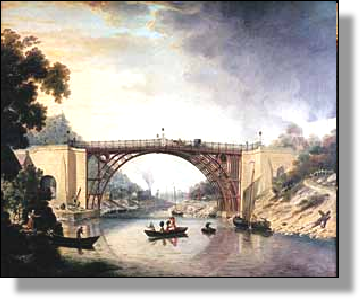 xxxxxAs we have seen, it was an Abraham Darby, an English
iron manufacturer based at Coalbrookdale, Shropshire, who, in 1709 (AN) came up with a way of
using coke instead of charcoal for smelting iron. This not only made
production substantially cheaper, but it also made possible the use
of much larger blast furnaces. Using and improving upon this method
of coke-smelting, his son, also named Abraham, expanded the family business. Amongst work
carried out by his workshop was the making of more than a hundred
cylinders for the new steam pumping engines, invented by the Devon
engineer Thomas Newcomen in 1712.
xxxxxAs we have seen, it was an Abraham Darby, an English
iron manufacturer based at Coalbrookdale, Shropshire, who, in 1709 (AN) came up with a way of
using coke instead of charcoal for smelting iron. This not only made
production substantially cheaper, but it also made possible the use
of much larger blast furnaces. Using and improving upon this method
of coke-smelting, his son, also named Abraham, expanded the family business. Amongst work
carried out by his workshop was the making of more than a hundred
cylinders for the new steam pumping engines, invented by the Devon
engineer Thomas Newcomen in 1712.
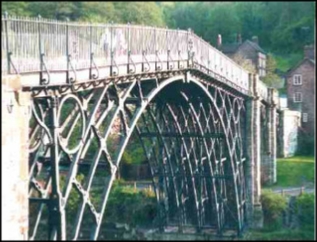 xxxxxBut it was left to his grandson, Abraham Darby III, to
put the family name firmly and indelibly in the history books. Inxthe mid 1770s he rebuilt and enlarged his grandfather's
famous blast furnace and then, working to plans put forward by the
English architect Thomas Pritchard (c1723-1777), he built the world's first cast-iron
bridge, completed in 1779. Made up of
great cast-iron "ribs", he constructed a near-semicircular
arch which, spanning a distance of just over 100 feet, was put in
place over the River Severn just a short distance from his iron
works. Assembled in three months from nearly 1700 components -
the heaviest weighing over 5 tonnes - it was 196 feet long and
50 feet high when completed. In place of today's nuts, bolts and
screws, it had "joints, pegs and keys". Known as the Coalbrookdale
Bridge, it was the very first time that iron had been used for
building purposes.
xxxxxBut it was left to his grandson, Abraham Darby III, to
put the family name firmly and indelibly in the history books. Inxthe mid 1770s he rebuilt and enlarged his grandfather's
famous blast furnace and then, working to plans put forward by the
English architect Thomas Pritchard (c1723-1777), he built the world's first cast-iron
bridge, completed in 1779. Made up of
great cast-iron "ribs", he constructed a near-semicircular
arch which, spanning a distance of just over 100 feet, was put in
place over the River Severn just a short distance from his iron
works. Assembled in three months from nearly 1700 components -
the heaviest weighing over 5 tonnes - it was 196 feet long and
50 feet high when completed. In place of today's nuts, bolts and
screws, it had "joints, pegs and keys". Known as the Coalbrookdale
Bridge, it was the very first time that iron had been used for
building purposes.
xxxxxLater, the furnaces at
Coalbrookdale were to supply the iron work for the first iron bridge
constructed by the Scottish bridge-builder Thomas Telford -
spanning the Severn at Buildwas. And they were also to make parts
for the pressure steam engines designed by the Cornishman Richard
Trevithick, and produce the first engine invented by the English
engineer George Stephenson in 1814. Meanwhile, as we shall see, in 1784 (G3b) the Englishman
Henry Cort was to show that there were still improvements to be made
in the quality of iron and the speed of its production.
xxxxxIncidentally,
the structure of Coalbrookdale Bridge proved successful in more ways
than one. In 1795 the Severn broke its banks. The floodwater passed
through Pritchard's design, but destroyed every other bridge in the
region - a fact which, as we shall see, did not go unnoticed by
the bridge-maker Thomas Telford. ......
xxxxx......
But not everyone welcomed the bridge. It
caused a storm of protest from the local boatmen, many of whom lost
their livelihood.
Acknowledgements
Bridge: by the
English/American painter William Williams (1727-1791), c1780
– Coalbrookdale Museum of Iron, Shropshire, England. Construction: date and artist unknown. Smeaton:
date and artist unknown – Temple Newsam House, Leeds Museums and
Galleries, Yorkshire. Smeaton Lighthouse:
detail, by the Irish illustrator William Gibbons (1841-1886),
1868 – Plymouth City Council Museum and Art Gallery, Devon,
England. Winstanley Lighthouse: after
an engraving of 1761 by the British artist Henry Roberts (18th
century) – contained in The Pictorial Gallery of Arts, edited by the English
author Charles Knight (1791-1873), and first published c1851.
Cordouan Rock:
by the French architect Claude Chastillon (c1559-1616).
G3a-1760-1783-G3a-1760-1783-G3a-1760-1783-G3a-1760-1783-G3a-1760-1783-G3a

xxxxxAnother English bridge-builder
of this period was the Yorkshire engineer John
Smeaton (1724-1792). He built a number
of bridges in Scotland, and was responsible for the Forth and Clyde
Canal. A man of many talents, he also constructed harbours, and,
using cast-iron wheels and gearing, greatly improved the
performance of watermills and windmills. He played a major part in
improving the steam engine invented by Newcomen, and used this
machine to pump out water in mines and docks. He is best remembered,
however, for his building of the third Eddystone lighthouse,
completed in 1759. Using stone for the first time, its unique design
proved very successful and was used world-wide. He introduced
the term "civil engineer" and, in 1771 formed the Society of Civil
Engineers, to promote public projects, and this proved the
forerunner of the Institution of Civil Engineers, founded in London
in 1818.
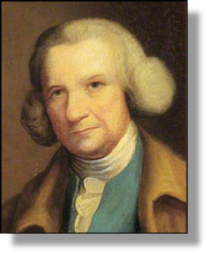 xxxxxAnother bridge builder of this period was the Yorkshire
engineer John Smeaton
(1724-92), a man of many talents. He constructed a number of
bridges in Scotland, including ones at Perth, Banff and Coldstream,
and was responsible for the Forth and Clyde Canal, which opened a
waterway between the Atlantic and the North Sea. He was also much in
demand for the building of harbours - such as the one at
Ramsgate in Kent - and he brought about, too, a vast
improvement in the construction and efficiency of watermills and
windmills. In 1776, for example, after a series of experiments, he
introduced the first cast-iron wheel, and provided cast-iron
gearing two years later. At one stage he built a huge wheel nearly
five metres wide for use in the London Bridge waterworks. For his
pioneer work in this direction he was awarded the Royal Society's
Copley Medal. And it was due to the improvements he made to
Newcomen's atmospheric
steam engine, that he was able to provide pumping engines for
numerous mines at home, and for docks as far afield as Kronshtadt in
Russia.
xxxxxAnother bridge builder of this period was the Yorkshire
engineer John Smeaton
(1724-92), a man of many talents. He constructed a number of
bridges in Scotland, including ones at Perth, Banff and Coldstream,
and was responsible for the Forth and Clyde Canal, which opened a
waterway between the Atlantic and the North Sea. He was also much in
demand for the building of harbours - such as the one at
Ramsgate in Kent - and he brought about, too, a vast
improvement in the construction and efficiency of watermills and
windmills. In 1776, for example, after a series of experiments, he
introduced the first cast-iron wheel, and provided cast-iron
gearing two years later. At one stage he built a huge wheel nearly
five metres wide for use in the London Bridge waterworks. For his
pioneer work in this direction he was awarded the Royal Society's
Copley Medal. And it was due to the improvements he made to
Newcomen's atmospheric
steam engine, that he was able to provide pumping engines for
numerous mines at home, and for docks as far afield as Kronshtadt in
Russia.
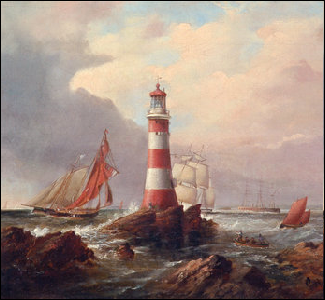 xxxxxBut today, Smeaton is probably best remembered as the
man who built the third Eddystone lighthouse, completed in 1759.
Erected to replace the wooden one which was destroyed by fire in
1755, it was a remarkable piece of construction. It was after he had
made a visit to the Low Countries, where he studied varying methods of building canals and harbours, that he
took on this challenging task. He used interlocking blocks of
Portland stone for extra strength, a specially prepared mortar to
withstand under-water conditions, and, for the first time, he
gave the structure a curved profile so that waves would sweep up the
wall, thereby reducing their impact. It was a design that was to be
followed world-wide. The methods he employed were described in
his Narrative of the Building of the Eddystone
Lighthouse, published in 1791. Whenxhis
lighthouse was replaced by the current one in 1882 - designed
by the English civil engineer Sir James
Douglass (1826-1898), it was rebuilt
on Plymouth Hoe in Devon as a memorial.
xxxxxBut today, Smeaton is probably best remembered as the
man who built the third Eddystone lighthouse, completed in 1759.
Erected to replace the wooden one which was destroyed by fire in
1755, it was a remarkable piece of construction. It was after he had
made a visit to the Low Countries, where he studied varying methods of building canals and harbours, that he
took on this challenging task. He used interlocking blocks of
Portland stone for extra strength, a specially prepared mortar to
withstand under-water conditions, and, for the first time, he
gave the structure a curved profile so that waves would sweep up the
wall, thereby reducing their impact. It was a design that was to be
followed world-wide. The methods he employed were described in
his Narrative of the Building of the Eddystone
Lighthouse, published in 1791. Whenxhis
lighthouse was replaced by the current one in 1882 - designed
by the English civil engineer Sir James
Douglass (1826-1898), it was rebuilt
on Plymouth Hoe in Devon as a memorial.
xxxxxSmeaton, who was elected
to the Royal Society in 1753, was the first person to use the term
"civil engineer" in order not to be confused with a "military"
engineer. In 1771 he formed the Society of Civil Engineers ("the
Smeatonians") to promote the building of large public projects (such
as canals, waterworks and, later, railways), and this was the
forerunner of the influential Institution of Civil 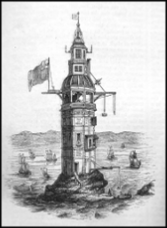 Engineers,
founded in London in 1818. It is perhaps little wonder that he is
sometimes referred to as the "Father of Civil Engineering".
Engineers,
founded in London in 1818. It is perhaps little wonder that he is
sometimes referred to as the "Father of Civil Engineering".
xxxxxIncidentally, thexfirst Eddystone
lighthouse was built by the English engineer Henry Winstanley
(1644-1703). Completed in 1698, it was a wooden octagonal
structure anchored to the rock by means of twelve huge iron
stanchions. It served its purpose well, but was totally destroyed by
a great storm in November 1703. The keepers and Winstanley himself -
on a visit to the tower at the time - were swept to their
deaths. ……
xxxxx ……
Thexsecond
lighthouse was the work of an English property developer named John Rudyard
(1650-c1718). A conical wooden structure which was surrounded
at its base by a thick wall of brick and concrete, it was
operational in 1709 and remained so until 1755. In that year,
however, fire broke out in the lantern-room and this quickly
destroyed the whole building. The three keepers managed to escape by
boat. ……
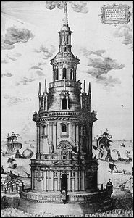 xxxxx…… Butxperhaps
the greatest success story in the building of lighthouses should
relate to the French engineer and architect Louis
de Foix (c1535-c1603). In 1581 he was
tasked with the building of a lighthouse on the Cordouan Rock at the
mouth of the Gironde estuary near Bordeaux - a notorious
graveyard for shipping. It took him over 20 years to complete, but
his vast cylindrical tower - complete with a chapel and royal
apartments - was built on a massive circular platform eight
feet high and 135ft in diameter, and, updated over the years, still
stands today. ……
xxxxx…… Butxperhaps
the greatest success story in the building of lighthouses should
relate to the French engineer and architect Louis
de Foix (c1535-c1603). In 1581 he was
tasked with the building of a lighthouse on the Cordouan Rock at the
mouth of the Gironde estuary near Bordeaux - a notorious
graveyard for shipping. It took him over 20 years to complete, but
his vast cylindrical tower - complete with a chapel and royal
apartments - was built on a massive circular platform eight
feet high and 135ft in diameter, and, updated over the years, still
stands today. ……
xxxxx……
As we shall see, it was in 1807 that work began on the famous Bell
Rock Lighthouse, off the east coast of Scotland. Constructed by the
Scottish civil engineers John Rennie and Robert
Stephenson, it was built on much the same
lines as Smeaton’s design.






 xxxxxAs we have seen, it was an Abraham Darby, an English
iron manufacturer based at Coalbrookdale, Shropshire, who, in 1709 (AN) came up with a way of
using coke instead of charcoal for smelting iron. This not only made
production substantially cheaper, but it also made possible the use
of much larger blast furnaces. Using and improving upon this method
of coke-
xxxxxAs we have seen, it was an Abraham Darby, an English
iron manufacturer based at Coalbrookdale, Shropshire, who, in 1709 (AN) came up with a way of
using coke instead of charcoal for smelting iron. This not only made
production substantially cheaper, but it also made possible the use
of much larger blast furnaces. Using and improving upon this method
of coke- xxxxxBut it was left to his grandson, Abraham Darby III, to
put the family name firmly and indelibly in the history books. Inxthe mid 1770s he rebuilt and enlarged his grandfather's
famous blast furnace and then, working to plans put forward by the
English architect Thomas Pritchard (c1723-
xxxxxBut it was left to his grandson, Abraham Darby III, to
put the family name firmly and indelibly in the history books. Inxthe mid 1770s he rebuilt and enlarged his grandfather's
famous blast furnace and then, working to plans put forward by the
English architect Thomas Pritchard (c1723-
 xxxxxAnother bridge builder of this period was the Yorkshire
engineer John Smeaton
(1724-
xxxxxAnother bridge builder of this period was the Yorkshire
engineer John Smeaton
(1724- xxxxxBut today, Smeaton is probably best remembered as the
man who built the third Eddystone lighthouse, completed in 1759.
Erected to replace the wooden one which was destroyed by fire in
1755, it was a remarkable piece of construction. It was after he had
made a visit to the Low Countries, where he studied varying methods of building canals and harbours, that he
took on this challenging task. He used interlocking blocks of
Portland stone for extra strength, a specially prepared mortar to
withstand under-
xxxxxBut today, Smeaton is probably best remembered as the
man who built the third Eddystone lighthouse, completed in 1759.
Erected to replace the wooden one which was destroyed by fire in
1755, it was a remarkable piece of construction. It was after he had
made a visit to the Low Countries, where he studied varying methods of building canals and harbours, that he
took on this challenging task. He used interlocking blocks of
Portland stone for extra strength, a specially prepared mortar to
withstand under- Engineers,
founded in London in 1818. It is perhaps little wonder that he is
sometimes referred to as the "Father of Civil Engineering".
Engineers,
founded in London in 1818. It is perhaps little wonder that he is
sometimes referred to as the "Father of Civil Engineering". xxxxx…… Butxperhaps
the greatest success story in the building of lighthouses should
relate to the French engineer and architect Louis
de Foix (c1535-
xxxxx…… Butxperhaps
the greatest success story in the building of lighthouses should
relate to the French engineer and architect Louis
de Foix (c1535-

